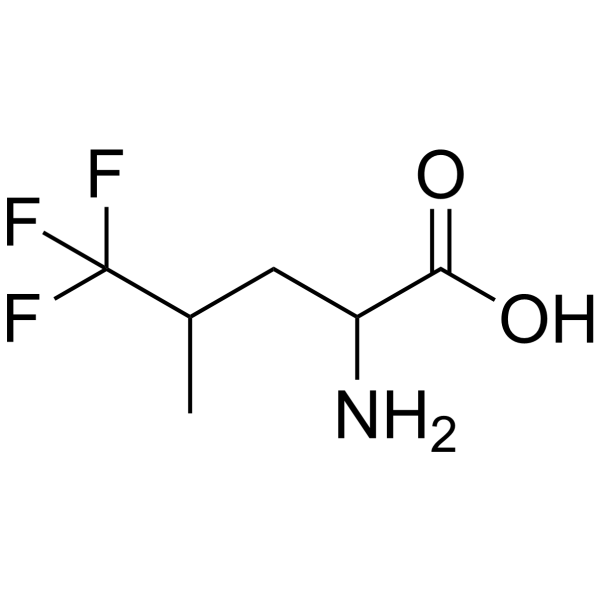5,5,5-TRIFLUORO-DL-LEUCINE

5,5,5-TRIFLUORO-DL-LEUCINE structure
|
Common Name | 5,5,5-TRIFLUORO-DL-LEUCINE | ||
|---|---|---|---|---|
| CAS Number | 2792-72-5 | Molecular Weight | 185.14400 | |
| Density | 1.294g/cm3 | Boiling Point | 217.4ºC at 760 mmHg | |
| Molecular Formula | C6H10F3NO2 | Melting Point | 273ºC | |
| MSDS | Chinese USA | Flash Point | 85.3ºC | |
| Symbol |

GHS07 |
Signal Word | Warning | |
Use of 5,5,5-TRIFLUORO-DL-LEUCINE5,5,5-Trifluoro-DL-leucine is a leucine derivative[1]. |
| Name | 5,5,5-trifluoroleucine |
|---|---|
| Synonym | More Synonyms |
| Description | 5,5,5-Trifluoro-DL-leucine is a leucine derivative[1]. |
|---|---|
| Related Catalog | |
| In Vitro | Amino acids and amino acid derivatives have been commercially used as ergogenic supplements. They influence the secretion of anabolic hormones, supply of fuel during exercise, mental performance during stress related tasks and prevent exercise induced muscle damage. They are recognized to be beneficial as ergogenic dietary substances[1]. |
| References |
| Density | 1.294g/cm3 |
|---|---|
| Boiling Point | 217.4ºC at 760 mmHg |
| Melting Point | 273ºC |
| Molecular Formula | C6H10F3NO2 |
| Molecular Weight | 185.14400 |
| Flash Point | 85.3ºC |
| Exact Mass | 185.06600 |
| PSA | 63.32000 |
| LogP | 1.68710 |
| Vapour Pressure | 0.0507mmHg at 25°C |
| Index of Refraction | 1.408 |
| Symbol |

GHS07 |
|---|---|
| Signal Word | Warning |
| Hazard Statements | H315-H319-H335 |
| Precautionary Statements | P261-P305 + P351 + P338 |
| Personal Protective Equipment | dust mask type N95 (US);Eyeshields;Gloves |
| Hazard Codes | Xi: Irritant; |
| Risk Phrases | R22;R36/37/38 |
| Safety Phrases | S26-S36/37/39 |
| RIDADR | NONH for all modes of transport |
| WGK Germany | 3 |
| HS Code | 2922499990 |
| HS Code | 2922499990 |
|---|---|
| Summary | HS:2922499990 other amino-acids, other than those containing more than one kind of oxygen function, and their esters; salts thereof VAT:17.0% Tax rebate rate:9.0% Supervision conditions:AB(certificate of inspection for goods inward,certificate of inspection for goods outward) MFN tariff:6.5% General tariff:30.0% |
|
The first isolation of two types of trifluoroleucine resistant mutants of Saccharomyces servazzii.
Biotechnol. Lett. 25(20) , 1735-8, (2003) Saccharomyces servazzii plays a crucial role in the making of Japanese radish pickles. To make more flavorsome pickles, we sought to generate trifluoroleucine-resistant mutants of S. servazzii. The th... |
|
|
Construction of two new vectors for transformation of laboratory, natural and industrial Saccharomyces cerevisiae strains to trifluoroleucine and G418 resistance.
Folia Microbiol. (Praha) 49(5) , 534-8, (2004) Two new plasmids, pEC3 and pECkan, were constructed and their use in yeast transformation described. Both plasmids are derivative of the pRS416 vector, in which the URA3 auxotrophic marker was replace... |
|
|
Self-association and membrane-binding behavior of melittins containing trifluoroleucine.
J. Am. Chem. Soc. 123(30) , 7407-13, (2001) We have investigated the effect of trifluoroleucine substitution on the membrane-binding and tetramerization behavior of melittin. Analogues were synthesized in which Leu 9, Leu 13, and all four intri... |
| 2-azanyl-5,5,5-trifluoro-4-methyl-pentanoic acid |
| 5,5,5-TRIFLUORO-DL-LEUCINE |
| 2-Amino-5,5,5-trifluor-4-methyl-valeriansaeure |
| MFCD00039528 |
| 2-amino-5,5,5-trifluoro-4-methyl-valeric acid |
| 2-amino-5,5,5-trifluoro-4-methylpentanoic acid |
| 2-amino-4-methyl-5,5,5-trifluoropentanoic acid |